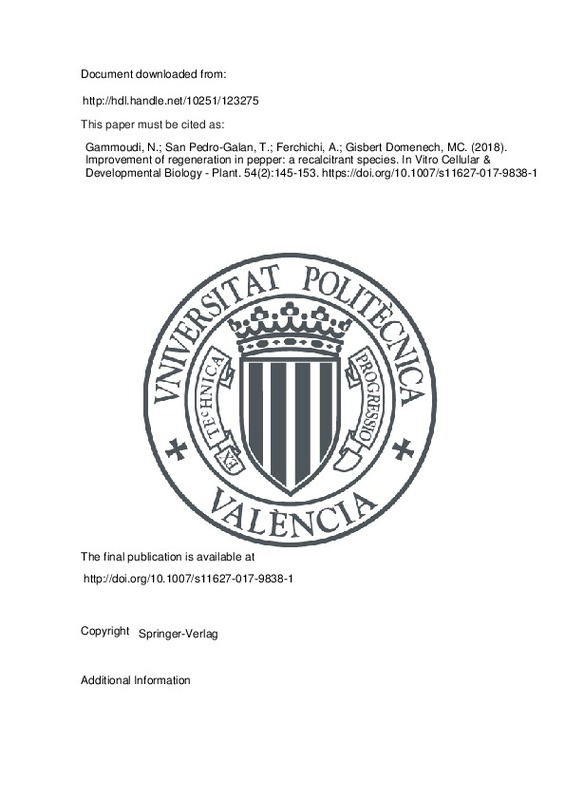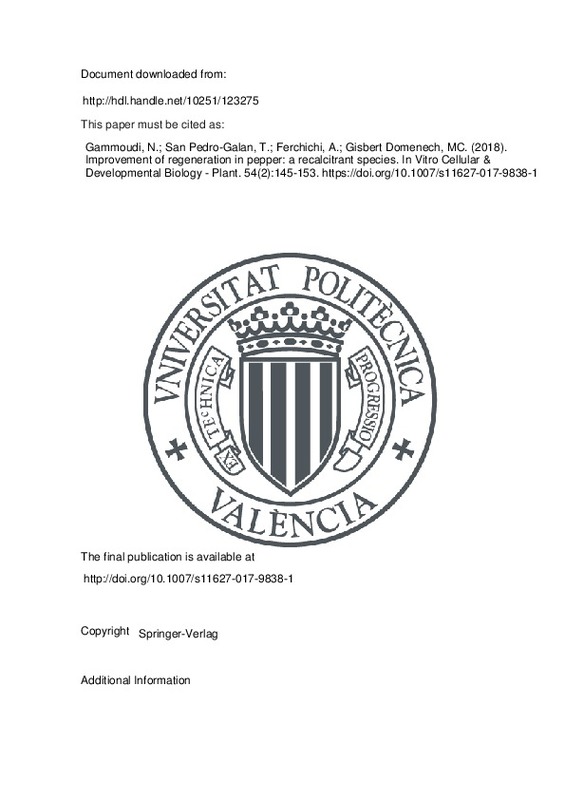JavaScript is disabled for your browser. Some features of this site may not work without it.
Buscar en RiuNet
Listar
Mi cuenta
Estadísticas
Ayuda RiuNet
Admin. UPV
Improvement of regeneration in pepper: a recalcitrant species
Mostrar el registro sencillo del ítem
Ficheros en el ítem
| dc.contributor.author | Gammoudi, N.
|
es_ES |
| dc.contributor.author | San Pedro-Galan, Tania
|
es_ES |
| dc.contributor.author | Ferchichi, A.
|
es_ES |
| dc.contributor.author | Gisbert Domenech, María Carmen
|
es_ES |
| dc.date.accessioned | 2019-07-07T20:01:35Z | |
| dc.date.available | 2019-07-07T20:01:35Z | |
| dc.date.issued | 2018 | es_ES |
| dc.identifier.issn | 1054-5476 | es_ES |
| dc.identifier.uri | http://hdl.handle.net/10251/123275 | |
| dc.description.abstract | [EN] Organogenesis is influenced by factors like genotype, type of explant, culture medium components, and incubation conditions. The influence of ethylene, which can be produced in the culture process, can also be a limiting factor in recalcitrant species like pepper. In this work, bud induction was achieved from cotyledons and hypocotyls-from eight pepper cultivars-on Murashige and Skoog (MS) medium supplemented with 22.2 mu M 6-benzyladenine (6BA) and 5.71 mu M indole-3-acetic acid (IAA), in media with or without silver nitrate (SN) (58.86 mu M), a suppressor of ethylene action. In the SN-supplemented medium, the frequencies of explants with buds and with callus formation were lower in both kinds of explant, but higher numbers of developed shoots were isolated from explants cultured on SN. Bud elongation was better in medium with gibberellic acid (GA(3)) (2.88 mu M) than in medium free of growth regulators or supplemented with 1-aminocyclopropane-1-carboxylic acid (ACC) at 34.5 mu M. However, isolation of shoots was difficult and few plants were recovered. The effect of adding SN following bud induction (at 7 d) and that of dark incubation (the first 7 d of culture) was also assessed in order to improve the previous results. When SN was added after bud induction, similar percentages of bud induction were found for cotyledons (average frequency 89.37% without SN and 94.37% with SN) whereas they doubled in hypocotyls (50% without SN and 87.7% with SN). In addition, in both kinds of explant, the number of developed plants able to be transferred to soil (developed and rooted) was greatly increased by SN. Dark incubation does not seem to improve organogenesis in pepper, and hypocotyl explants clearly represent a better explant choice-with respect to cotyledonary explants-for the pepper cultivars assayed. | es_ES |
| dc.description.sponsorship | We thank the COMAV germplasm bank at Universitat Politecnica de Valencia and the Arid Lands Institute for pepper seeds and the Tunisian Ministry of Higher Education and Scientific Research who fund N. Gammoudi's stay. | es_ES |
| dc.language | Inglés | es_ES |
| dc.publisher | Springer-Verlag | es_ES |
| dc.relation.ispartof | In Vitro Cellular & Developmental Biology - Plant | es_ES |
| dc.rights | Reserva de todos los derechos | es_ES |
| dc.subject | Capsicum | es_ES |
| dc.subject | Ethylene | es_ES |
| dc.subject | Organogenesis | es_ES |
| dc.subject | AgNO3 | es_ES |
| dc.subject | ACC | es_ES |
| dc.subject.classification | GENETICA | es_ES |
| dc.title | Improvement of regeneration in pepper: a recalcitrant species | es_ES |
| dc.type | Artículo | es_ES |
| dc.identifier.doi | 10.1007/s11627-017-9838-1 | es_ES |
| dc.rights.accessRights | Abierto | es_ES |
| dc.contributor.affiliation | Universitat Politècnica de València. Departamento de Biotecnología - Departament de Biotecnologia | es_ES |
| dc.description.bibliographicCitation | Gammoudi, N.; San Pedro-Galan, T.; Ferchichi, A.; Gisbert Domenech, MC. (2018). Improvement of regeneration in pepper: a recalcitrant species. In Vitro Cellular & Developmental Biology - Plant. 54(2):145-153. https://doi.org/10.1007/s11627-017-9838-1 | es_ES |
| dc.description.accrualMethod | S | es_ES |
| dc.relation.publisherversion | http://doi.org/10.1007/s11627-017-9838-1 | es_ES |
| dc.description.upvformatpinicio | 145 | es_ES |
| dc.description.upvformatpfin | 153 | es_ES |
| dc.type.version | info:eu-repo/semantics/publishedVersion | es_ES |
| dc.description.volume | 54 | es_ES |
| dc.description.issue | 2 | es_ES |
| dc.relation.pasarela | S\337223 | es_ES |
| dc.contributor.funder | Ministère de l'Enseignement Supérieur et de la Recherche Scientifique, Túnez | |
| dc.description.references | Ashrafuzzaman M, Hossain MM, Razi Ismail M, Shahidul Haque M, Shahidullah SM, Uz Zaman S (2009) Regeneration potential of seedling explants of chilli (Capsicum annuum). Afr J Biotechnol 8:591–596 | es_ES |
| dc.description.references | Bortesi L, Fischer R (2015) The CRISPR/Cas9 system for plant genome editing and beyond. Biotechnol Adv 33:41–52 | es_ES |
| dc.description.references | Brooks C, Nekrasov V, Lippman ZB, Van Eck J (2014) Efficient gene editing in tomato in the first generation using the clustered regularly interspaced short palindromic repeats/CRISPR-associated9 system. Plant Physiol 166:1292–1297 | es_ES |
| dc.description.references | Brown DC, Thorpe TA (1995) Crop improvement through tissue culture. World J Microbiol Biotechnol 11:409–415 | es_ES |
| dc.description.references | Carvalho MAF, Paiva R, Stein VC, Herrera RC, Porto JMP, Vargas DP, Alves E (2014) Induction and morpho-ultrastructural analysis of organogenic calli of a wild passion fruit. Braz Arch Biol Technol 57:581–859 | es_ES |
| dc.description.references | Christopher T, Rajam MV (1996) Effect of genotype, explant and medium on in vitro regeneration of red pepper. Plant CellTiss Org Cult 46:245–250 | es_ES |
| dc.description.references | Dabauza M, Peña L (2001) High efficiency organogenesis in sweet pepper (Capsicum annuum L.) tissues from different seedling explants. Plant Growth Regul 33:221–229 | es_ES |
| dc.description.references | De Filippis LF (2014) Crop improvement through tissue culture. In: Ahmad P, Wani MR, Azooz MM, Tran LSP (eds) Improvement of crops in the era of climate changes, vol 1. Springer, New York, pp 289–346 | es_ES |
| dc.description.references | Gammoudi N, Ben Yahia L, Lachiheb B, Ferchichi A (2016) Salt response in pepper (Capsicum annuum L.): components of photosynthesis inhibition, proline accumulation and K+/Na+ selectivity. JJ Aridland Agri 2:1–12 | es_ES |
| dc.description.references | González A, Arigita L, Majada J, Sánchez Tamés R (1997) Ethylene involvement in in vitro organogenesis and plant growth of Populus tremula L. Plant Growth Regul 22:1–6 | es_ES |
| dc.description.references | Grozeva S, Rodeva V, Todorova V (2012) In vitro shoot organogenesis in Bulgarian sweet pepper (Capsicum annuum L.) varieties. EJBio 8:39–44 | es_ES |
| dc.description.references | Gunay AL, Rao PS (1978) In vitro plant regeneration from hypocotyls and cotyledon explants of red pepper (Capsicum). Plant Sci Lett 11:365–372 | es_ES |
| dc.description.references | Huxter TJ, Thorpe TA, Reid DM (1981) Shoot initiation in light- and dark-grown tobacco callus: the role of ethylene. Physiol Plant 53:319–326 | es_ES |
| dc.description.references | Hyde CL, Phillips GC (1996) Silver nitrate promotes shoot development and plant regeneration of chile pepper (Capsicum annuum L.) via organogenesis. In Vitro-Plant 32:72–80 | es_ES |
| dc.description.references | Kothari SL, Joshi A, Kachhwaha S, Ochoa-Alejo N (2010) Chilli peppers—a review on tissue culture and transgenesis. Biotechnol Adv 28:35–48 | es_ES |
| dc.description.references | Kumar AO, Rupavathi T, Tata SS (2012) Adventitious shoot bud induction in chili pepper (Capsicum annuum L. cv. X-235). In J Sci Nat 3:192–196 | es_ES |
| dc.description.references | Kumar PP, Lakshmanan P, Thorpe TA (1998) Regulation of morphogenesis in plant tissue culture by ethylene. In Vitro Cell Dev Biol Plant 34:94–103 | es_ES |
| dc.description.references | Liu W, Parrott WA, Hildebrand DF, Collins GB, Williams EG (1990) Agrobacterium induced gall formation in bell pepper (Capsicum annuum L.) and formation of shoot-like structures expressing introduced genes. Plant Cell Rep 9:360–364 | es_ES |
| dc.description.references | Maligeppagol M, Manjula R, Navale PM, Babu KP, Kumbar BM, Laxman RH (2016) Genetic transformation of chilli (Capsicum annuum L.) with Dreb1A transcription factor known to impart drought tolerance. Indian J Biotechnol 15:17–24 | es_ES |
| dc.description.references | Mantiri FR, Kurdyukov S, Chen SK, Rose RJ (2008) The transcription factor MtSERF1 may function as a nexus between stress and development in somatic embryogenesis in Medicago truncatula. Plant Signal Behav 3:498–500 | es_ES |
| dc.description.references | Mezghani N, Jemmali A, Elloumi N, Gargouri-Bouzid R, Kintzios S (2007) Morpho-histological study on shoot bud regeneration in cotyledon cultures of pepper (Capsicum annuum). Biologia 62:704–710 | es_ES |
| dc.description.references | Mohamed-Yasseen Y (2001) Influence of agar and activated charcoal on uptake of gibberellin and plant morphogenesis in vitro. In Vitro Cell Dev Biol - Plant 37:204–205 | es_ES |
| dc.description.references | Moshkov IE, Novikova GV, Hall MA, George EF (2008) Plant growth regulators III: ethylene. In: George EF, Hall MA, Klerk G-JD (eds) Plant propagation by tissue culture, vol 1, 3rdedn. Springer, Dordrecht, The Netherlands, pp 239–248 | es_ES |
| dc.description.references | Murashige T, Skoog F (1962) A revised medium for rapid growth and bioassays with tobacco tissue cultures. Physiol Plant 15:473–497 | es_ES |
| dc.description.references | Nogueira RC, Paiva R, de Oliveira LM, Soares GA, Soares FP, Castro AHF, Paiva PDO (2007) Calli induction from leaf explants of murici-pequeno (Byrsonima intermedia A. Juss.) Ciênc Agrotec 31:366–370 | es_ES |
| dc.description.references | Ochoa-Alejo N, Ramirez-Malagon R (2001) In vitro chili pepper biotechnology. In Vitro Cell Devl Biol Plant 37:701–729 | es_ES |
| dc.description.references | Orlińska M, Nowaczy P (2015) In vitro plant regeneration of 4 Capsicum spp. genotypes using different explant types. Turk J Biol 39:60–68 | es_ES |
| dc.description.references | Reid MS (1995) Ethylene in plant growth, development and senescence. In: Davies PJ (ed) Plant hormones: physiology, biochemistry and molecular biology, 2nd edn. Kluwer Acad Publ, Dordrecht, The Netherlands, pp 486–508 | es_ES |
| dc.description.references | Sanatombi K, Sharma GJ (2008) In vitro plant regeneration in six cultivars of Capsicum spp. using different explants. Biol Plant 52:141–145 | es_ES |
| dc.description.references | Santana-Buzzy N, Canto-Flick A, Barahona-Pérez F, Montalvo-Peniche MC, Zapata-Castillo PY, Solís-Ruiz A, Zaldívar-Collí A, Gutiérrez-Alonso O, Miranda-Ham ML (2005) Regeneration of habanero pepper (Capsicum chinense Jacq.) via organogenesis. Hortscience 40:1829–1831 | es_ES |
| dc.description.references | Santana-Buzzy N, Canto-Flick A, Iglesias-Andreu LG, Montalvo-Peniche MC, López-Puc G, Barahona-Pérez F (2006) Improvement of in vitro culturing of habanero pepper by inhibition of ethylene effects. Hortscience 41:405–409 | es_ES |
| dc.description.references | Sawai S, Ohyama K, Yasumoto S, Seki H, Sakuma T, Yamamoto T, Takebayashi Y, Kojima M, Sakakibara H, Aoki T, Muranaka T, Saito K, Umemoto N (2014) Sterol side chain reductase 2 is a key enzyme in the biosynthesis of cholesterol, the common precursor of toxic steroidal glycoalkaloids in potato. Plant Cell 26:3763–3774 | es_ES |
| dc.description.references | Shah SH, Ali S, Jan SA, Din J, Ali GM (2014) Assessment of silver nitrate on callus induction and in vitro shoot regeneration in tomato (Solanum lycopersicum Mill.) Pakistan J Bot 46:2163–2172 | es_ES |
| dc.description.references | Steinitz B, Wolf D, Matzevitch-Josef T, Zelcer A (1999) Regeneration in vitro and genetic transformation of pepper (Capsicum spp.): the current state of the art. Capsicum Eggplant Plant Newsletter 18:9–15 | es_ES |
| dc.description.references | Tamimi SM (2015) Effects of ethylene inhibitors, silver nitrate (AgNO3), cobalt chloride (CoCl2) and aminooxyacetic acid (AOA), on in vitro shoot induction and rooting of banana (Musa acuminata L.) Afr J Biotechnol 14:2510–2516 | es_ES |
| dc.description.references | Trujillo-Moya C, Gisbert C (2012) The influence of ethylene and ethylene modulators on shoot organogenesis in tomato. Plant Cell Tissue Organ Cult 111:41–48 | es_ES |
| dc.description.references | Yasmin S, Mensuali-Sodi A, Perata P, Pucciariello C (2014) Ethylene influences in vitro regeneration frequency in the FR13A rice harbouring the SUB1A gene. Plant Growth Reg 72:97–103 | es_ES |
| dc.description.references | Zhao Y, Stiles AR, Saxena PK, Liu CZ (2013) Dark preincubation improves shoot organogenesis from Rhodiola crenulata leaf explants. Biol Plant 57:189–192 | es_ES |








![[Cerrado]](/themes/UPV/images/candado.png)

